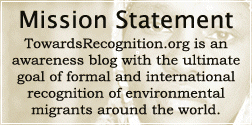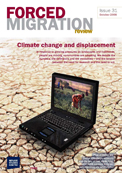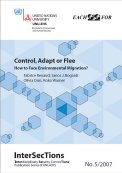
The Emblem of the AU
The African Union (AU), which is an intergovernmental organization consisting of 52 African states, held the Special Summit for the Protection and Assistance of Internally Displaced Persons in Africa this week. It took place in Kampala, Uganda and concluded yesterday, running from October 19 to October 23. The theme of the summit was “Addressing the Challenge of Forced Displacement in Africa”.
The summit was a success and out of it came the adoption of the groundbreaking Convention on Protection and Assistance to Internally Displaced Persons in Africa. The Convention is the first continent-wide instrument to address the specific plight of internally displaced people. It integrates the main aspects of international humanitarian law and will oblige AU states for the first time to prevent internal displacement, come up with solutions to the causes of displacement, and provide internally displaced people with basic rights. People forced to flee will find in the Convention the full range of rights they should be entitled to – before, during and after displacement. For the Convention to enter into force, at least 15 AU member states would have to ratify it.
The Convention is also the first of its kind in many ways with regards to legitimizing increasing environmental migration and displacement. It is a legally binding regional treaty that recognizes the multiple causes of internal displacement, including natural disasters and climate change as drivers of this phenomenon. In 2008, there were 104 internationally reported natural disasters, 99 percent of which were climate related. Moreover, the number of people in Africa affected by natural disasters has doubled over the last 20 years, from 9 million in 1989 to nearly 17 million in 2008.
The actual entry relating to climate change displacement in the Convention can be found Article 5: “Obligations of States Parties relating to Protection and Assistance”, Section 4, and states:
“States Parties shall take measures to protect and assist persons who have been internally displaced due to natural or human made disasters, including climate change.”
United Nations Under-Secretary-General for Humanitarian Affairs and Emergency Relief Coordinator John Holmes was in attendance. “In reality, displacement prompted by natural disasters and climate change, and the resultant food and water shortages, promise to be one of the greatest – if not the greatest – challenge many countries will face in the years ahead,” stressed Mr. Holmes in a speech during the summit. “Many of you here today already know all too well from recent painful experiences how climate change is increasing the frequency and intensity of extreme natural-hazard events, particularly floods, storms and droughts,” he added.
The recognition of climate change as a driver of displacement in this AU instrument sends a signal to the rest of the international community, including the United Nations, about the seriousness with which Africa, home to around half of the global total of internally displaced persons, considers this issue.




While the Earth has always endured natural climate change variability, we are now facing the possibility of irreversible climate change in the near future. The increase of greenhouse gases in the Earth?s atmosphere from industrial processes has enhanced the natural greenhouse effect. This in turn has accentuated the greenhouse ?trap? effect, causing greenhouse gases to form a blanket around the Earth, inhibiting the sun?s heat from leaving the outer atmosphere. This increase of greenhouse gases is causing an additional warming of the Earth?s surface and atmosphere. A direct consequence of this is sea-level rise expansion, which is primarily due to the thermal expansion of oceans (water expands when heated), inducing the melting of ice sheets as global surface temperature increases.
Forecasts for climate change by the 2,000 scientists on the United Nations Intergovernmental Panel on Climate Change (IPCC) project a rise in the global average surface temperature by 1.4 to 5.8°C from 1990 to 2100. This will result in a global mean sea level rise by an average of 5 mm per year over the next 100 years. Consequently, human-induced climate change will have ?deleterious effects? on ecosystems, socio-economic systems and human welfare.At the moment, especially high risks associated with the rise of the oceans are having a particular impact on the two archipelagic states of Western Polynesia: Tuvalu and Kiribati. According to UN forecasts, they may be completely inundated by the rising waters of the Pacific by 2050.According to the vast majority of scientific investigations, warming waters and the melting of polar and high-elevation ice worldwide will steadily raise sea levels. This will likely drive people off islands first by spoiling the fresh groundwater, which will kill most land plants and leave no potable water for humans and their livestock. Low-lying island states like Kiribati, Tuvalu, the Marshall Islands and the Maldives are the most prominent nations threatened in this way.“The biggest challenge is to preserve their nationality without a territory,” said Bogumil Terminski from Geneva. The best solution is continue to recognize deterritorialized states as a normal states in public international law. The case of Kiribati and other small island states is a particularly clear call to action for more secure countries to respond to the situations facing these ‘most vulnerable nations’, as climate change increasingly impacts upon their lives.